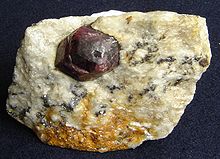Almandine: Difference between revisions
No edit summary |
No edit summary |
||
| Line 49: | Line 49: | ||
{{commonscat|Almandine}} |
{{commonscat|Almandine}} |
||
[[Category:Silicate minerals]] |
|||
[[Category:Garnet group]] |
[[Category:Garnet group]] |
||
Revision as of 19:43, 30 January 2008
| Almandine | |
|---|---|
 | |
| General | |
| Category | Mineral |
| Identification | |
| Color | reddish orange to red, slightly purplish red to reddish purple and usually dark in tone |
| Cleavage | none |
| Fracture | conchoidal [1] |
| Mohs scale hardness | 7 - 7.5 |
| Luster | greasy to vitreous |
| Specific gravity | 4.05 (+.25, -.12) [1] |
| Polish luster | vitreous to subadamantine [1] |
| Optical properties | Single refractive, and often anomalous double refractive [1] |
| Refractive index | 1.790 (+/- .030) [1] |
| Birefringence | none |
| Pleochroism | none |
| Dispersion | .024 [1] |
| Ultraviolet fluorescence | inert |
| Absorption spectra | usually at 504, 520, and 573nm, may also have faint lines at 423, 460, 610 and 680-690nm [1] |
Almandine, also known incorrectly as almandite, is a species of mineral belonging to the garnet group. The name is a corruption of alabandicus, which is the name applied by Pliny the Elder to a stone found or worked at Alabanda, a town in Caria in Asia Minor (modern Turkey). Almandine is an iron alumina garnet, of deep red color, inclining to purple. It is frequently cut with a convex face, or en cabochon, and is then known as carbuncle. Viewed through the spectroscope in a strong light, it generally shows three characteristic absorption bands. Almandine is one end-member of a mineral solid solution series, with the other end-member being the garnet pyrope. The almandine crystal formula is: Fe3Al2(SiO4)3. Magnesium substitutes for the iron with increasingly pyrope-rich composition.
Almandine occurs rather abundantly in the gemstone gravels of Sri Lanka, whence it has sometimes been called Ceylon-ruby. When the color inclines to a violet tint, the stone is often called Syrian garnet, a name said to be taken from Syriam, an ancient town of Pegu. Large deposits of fine almandine-garnets were found, some years ago, in the Northern Territory of South Australia, and were at first taken for rubies and thus they were known in trade for some time afterwards as Australian rubies.

Almandine is widely distributed. Fine rhombic dodecahedra occur in the schistose rocks of the Zillertal, in Tyrol, and are sometimes cut and polished. An almandine in which the ferrous oxide is replaced partly by periclase is found at Luisenfeld in what was formerly German East Africa. In the United States there are many localities which yield almandine. Fine crystals of almandine embedded in mica-schist occur near Fort Wrangell in Alaska. The coarse varieties of almandine are often crushed for use as an abrasive agent.
References
- ^ a b c d e f g Gemological Institute of America, GIA Gem Reference Guide 1995, ISBN:0-87311-019-6
- This article incorporates text from a publication now in the public domain: Chisholm, Hugh, ed. (1911). Encyclopædia Britannica (11th ed.). Cambridge University Press.
{{cite encyclopedia}}: Missing or empty|title=(help)
